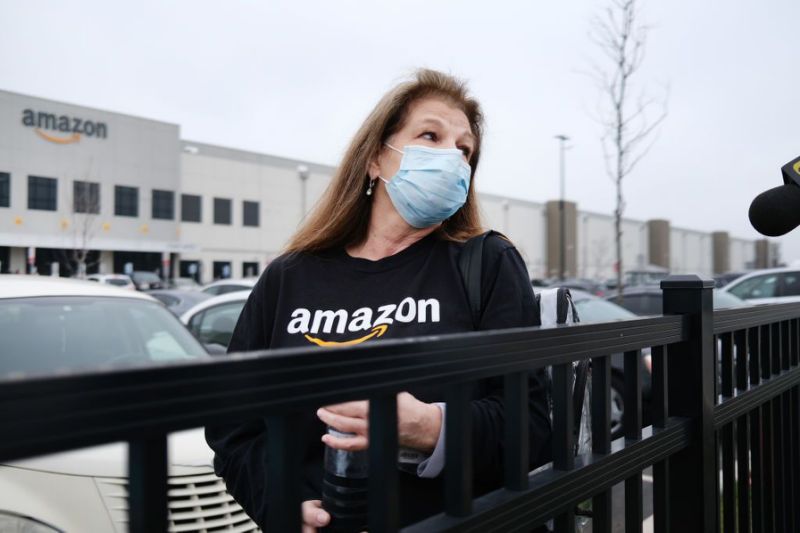
(Bloomberg Opinion) — E-commerce giant Amazon.com Inc. has the type of business that one would expect to thrive in a pandemic — but it’s not so clear-cut, as its most recent results released late Thursday show. And the challenges it faces to meet the soaring demand for its offerings are likely going to crimp its profitability for the foreseeable future.
Amazon posted first-quarter sales of $75.5 billion, up 26% from a year earlier, as self-isolating consumers shifted spending online rather than risk getting infected by the coronavirus at physical stores. Earnings, however, fell short of Wall Street estimates as shipping costs surged 49% to meet the rising number of deliveries required. Amazon also projected it could lose money in its current quarter due to $4 billion or more in Covid-19 related expenses. It shares fell in post-market trading.Jeff Bezos, Amazon’s founder and CEO, seemed to recognize shareholders wouldn’t be too excited about the company’s profit forecast, encouraging them instead to look at the big picture. “If you’re a shareowner in Amazon, you may want to take a seat, because we’re not thinking small,” he said in company’s earnings release as he explained that the additional spending was required to protect its employees and deliver products to its customers. He said the company will step up safety measures — including protective equipment, virus testing and increased social distancing inside its warehouses — and confirmed Amazon has now hired 175,000 additional workers, as it had flagged in March and April.In some ways, the additional spending is a prudent decision. At a time when most companies are getting decimated, it wouldn’t be wise to generate billions of dollars in profit at the expense of Amazon’s employees, especially as it faces criticism over its labor and safety practices. But beyond the larger workforce, the logistical challenges of dealing with the pandemic could lead to more problems elsewhere.One thing to watch is growing discontent among Amazon’s business clients who sell on its marketplace platform. These sellers have been getting squeezed as Amazon has prioritized the stocking and delivery of essential items such as household staples and medical supplies, leading to longer delivery times and fulfillment delays. Moreover, the Wall Street Journal reported last week that Amazon employees used third-party seller data to develop its own competing products. If true, it runs counter to what the company has explicitly promised it wouldn’t do. Amazon said it has launched an internal investigation into incidents referenced in the Journal.
The problem for Amazon is that sellers now have an actual alternative to go elsewhere. Over the past year, Shopify Inc. has been building out its own fulfillment network that allows its clients to ship boxes cloaked in their own brands. The upstart says the aggregated online sales of its U.S. customer base rank as the second-largest in the country after Amazon, giving it the scale to compete. Together with the lower profitability structure from higher expenses and increased shipping costs, the potential loss of some high-margin sellers could become a real issue should it become a more permanent state of affairs.
Amazon wasn’t the only Big Tech company disappointing the market Thursday. Apple Inc. reported its own results, which included an iPhone segment sales drop of 7% for the March quarter. The smartphone maker also uncharacteristically declined to give guidance for its current quarter that seems to have spooked investors with its shares falling nearly 3% in after-hours. As I mentioned earlier this week, Apple faces potential supply-chain disruptions and weakening demand for its smartphones this year, and that’s double trouble.
This column does not necessarily reflect the opinion of the editorial board or Bloomberg LP and its owners.
Tae Kim is a Bloomberg Opinion columnist covering technology. He previously covered technology for Barron’s, following an earlier career as an equity analyst.
<p class="canvas-atom canvas-text Mb(1.0em) Mb(0)–sm Mt(0.8em)–sm" type="text" content="For more articles like this, please visit us at bloomberg.com/opinion” data-reactid=”25″>For more articles like this, please visit us at bloomberg.com/opinion
<p class="canvas-atom canvas-text Mb(1.0em) Mb(0)–sm Mt(0.8em)–sm" type="text" content="Subscribe now to stay ahead with the most trusted business news source.” data-reactid=”26″>Subscribe now to stay ahead with the most trusted business news source.
©2020 Bloomberg L.P.











Add Comment